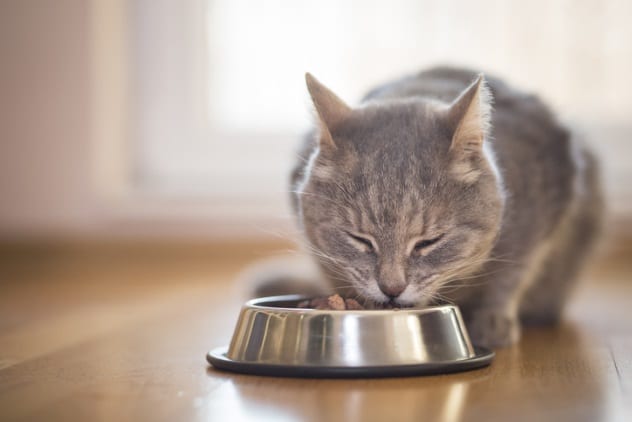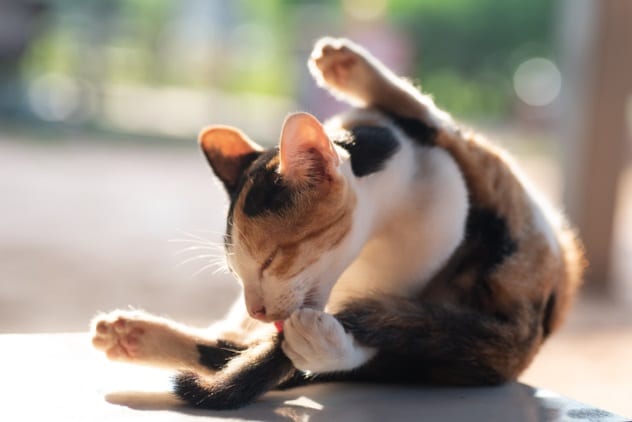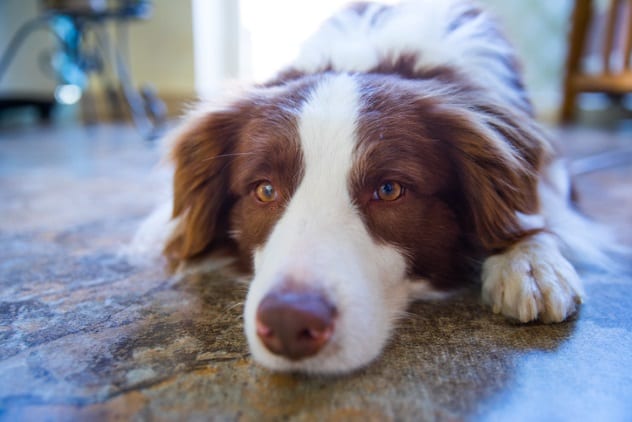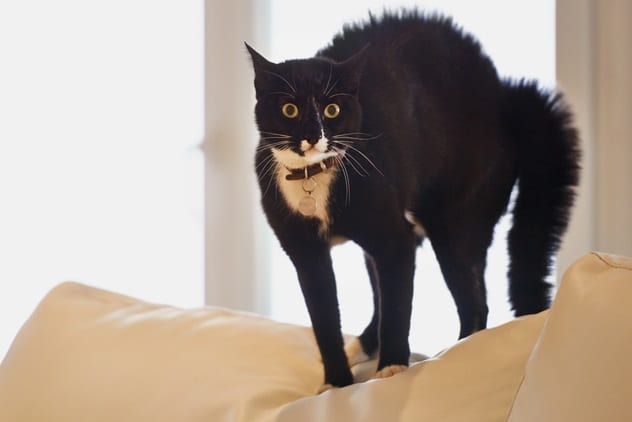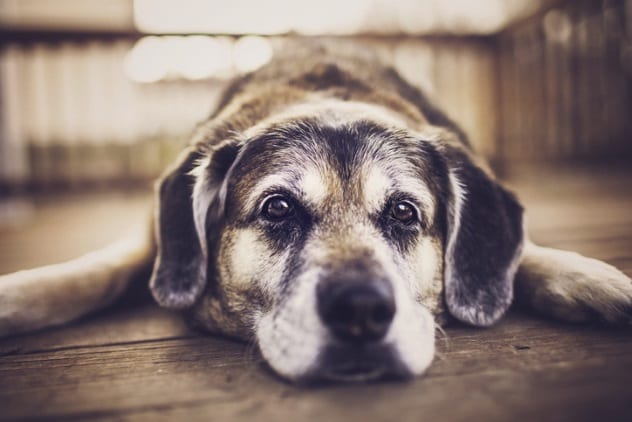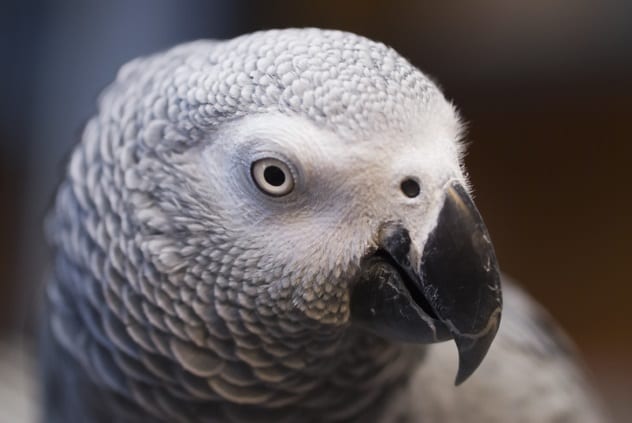But the drive for better pet health care has brought an issue to light that was previously unknown to the population at large: Pets need mental health care. Our animals, be they mammal or otherwise, can suffer from myriad mental illnesses and disorders just like we do. Pets also take medication, have therapy, and recover just like we do. As more of us are realizing how important it is to treat our pets’ mental health, it is more important than ever to ask what is causing the distress in the first place. Between our hectic lives and loud modern environment, we may be more responsible than we’d like to admit.
10 Pica
Most dog owners have a hilarious story about how their dog chewed up something important, like homework, or infeasible, like a chunk of drywall, and many cat owners know that it’s impossible for their feline companion to resist a nibble of any plastic bag left out for even one second. What people don’t tend to realize is the extreme cost of this behavior, in both actual money and danger to pets. When an animal eats something that isn’t food, it’s called pica. In cats, it is sometimes known as wool-sucking behavior due to a habit that Oriental breeds and too-early-weaned cats have of nursing on anything soft and fuzzy, usually wool. In dogs, it’s often known as eating your homework. Regardless of the terminology, pica can range from a minor inconvenience to a life-threatening disorder. Despite the wild tales of garbage-eating dogs and yarn-slurping cats, a small mammal’s digestive tract isn’t that ironclad. Cats especially suffer from obstructions when they eat random objects off of the floor, and the procedures to fix it can set owners back several thousand dollars. And the surgery to remove a hairpin or slipper from a treasured pet’s intestines won’t fix the behavior, so owners might find themselves right back at the emergency vet’s as soon as the pet has healed if they don’t seek mental health treatment. When pica is caused by a nutritional deficiency or dental problem, it is fairly easy to treat. However, pica is often due to boredom or separation anxiety. When this is the case, it can be harder to treat, but more time and play can sometimes solve it. But some pets eat nonfood items compulsively,[2] and that can often only be treated by locking the items away and cleaning a little more obsessively.
9 Binge Eating
It’s difficult to know if our animal companions suffer from eating disorders as we do, since we can’t easily confirm the mental and emotional drive behind a pet’s eating habits. What we can know is that some animals eat rarely, such as when a pig suffers from thin sow syndrome, and some eat to excess, such as dogs that can eat 16 percent of their body weight per feeding if allowed.[3] Cats and dogs can suffer from overeating and binge eating, but the problem extends to even more exotic animals. Binge eating in humans is sometimes studied by attempting to recreate the disordered behaviors in rats and mice, with reasonable success. Most animals want to eat and will stuff themselves if allowed. Veterinarians warn about the dangers of overeating in virtually all small pets, including birds, reptiles, amphibians, rodents, rabbits, and hedgehogs. But many people, professionals and laymen alike, note that you rarely see an overweight animal in the wild. Animals without enough excitement in their lives will often fall back on food for their entertainment, and food-seeking behavior is a necessary adaptation for animals that would have to catch their own meals in the wild. Cats left to their own devices, like those kept on farms, tend to keep themselves busy chasing prey. So treatment for binge eating in pets tends to focus on more exercise, more entertainment, and less food. The last item tends to be the hardest for many owners. When our cute dogs and cats beg for food, it’s hard to deny them. We don’t call them puppy dog eyes for nothing. But professionals suggest diverting a pet’s attention to some kind of activity instead. A bored pet will often literally jump at the chance to play and forget all about the treats.
8 Trichotillomania
Hairballs are a common problem for those who keep cats. Grooming is important for felines, and a lot of fur can end up swallowed in the process. Hairballs are normal, though, and cats that produce them are rarely in any danger. It’s only when a pet starts to groom so obsessively that their fur becomes patchy and their skin irritated that owners should worry. Trichotillomania, “trich” for short, is a compulsive disorder that causes sufferers to pluck their hair uncontrollably and for non-cosmetic reasons. In animals, this is often called over-grooming, and it is most often a response to stress. For most mammals, dogs and cats included, grooming behaviors release calming endorphins.[4] Many a human has a bath bomb collection for the same reason. Obsessive grooming, like trich, is a calming habit that becomes too much. In some extreme cases, a pet may leave themselves virtually bald by over-grooming. In cats and dogs, licking tends to happen in places that are easily reached. This can be paws but is more often a place that is harder to spot, like the thighs and underbelly. In rodents, trich is known as barbering and results in bald patches, nibbled whiskers, and irritation both physical and mental. Dominant mice will groom submissive mice normally, but the submissive mice get the worst of it when the dominant mouse experiences extreme stress. Often, a group of healthy mice will be shipped somewhere and arrive with all but one or two balding and annoyed. Even hairless creatures, like birds, exhibit feather-destructive behaviors. No one knows why a bird starts to pluck itself, if the behavior exists in the wild, or how to fix it. Even well-enriched birds in an ideal environment will develop trich. This is true of humans as well and may hint at genetic origins. For many, helping with trich is a matter of adjusting the environment until the behavior calms down and hoping that it goes away and stays away.
7 Autism
Autism spectrum disorder is not so often considered an illness anymore. Many consider autism to be a perfectly normal facet of human psychology that is misconstrued to be a disorder, while others contend that the difficulties faced by autistic individuals justify the disorder classification. Outside of this hotly contested point, the question that some animal researchers have is whether or not dogs can be said to have autism. When a dog whips around in circles to chase its tail, it’s adorable. However, it’s also a repetitive behavior that resembles the spinning and other repetitive motions that autistic people exhibit. And not all dogs chase their tails. It’s linked to certain breeds and certain genetic lines, particularly Bull Terriers, which are the go-to breed for exploring possible canine autism.[5] This breed is known for its quirky behaviors, including obsessive tail-chasing, chewing, and playing. They also have more breed-specific oddities. “Trancing” occurs when the dogs come to a slow-motion stop in the midst of play to stare off into the middle distance. “Ghost-walking” or “moon-walking” is a sort of gliding motion that they take on when sneaking under shrubbery. And Bull Terrier lovers affectionately refer to a particular gait where the butt is tucked under and the dog wildly runs as “Hucklebutting.” Obsessive tail-chasing seems to be the best marker to follow when determining whether or not a Bull Terrier may exhibit autism-like traits. Tail-chasing disproportionately affects males and is correlated with partial seizures, skin conditions, gastrointestinal issues, and fixations. As far as behavior goes, this subset tends to be less social with other dogs and humans as well. Nicholas Dodman, a veterinary behaviorist at Tufts University, has studied children with autism alongside Bull Terriers to determine whether or not this theory holds water. Two blood chemicals associated with autism, neurotensin and corticotropin-releasing hormone, were tested between children with autism, Bull Terriers, and a control group. The chemicals were higher in both the children and dogs, lending a little more weight to the study of autism in animals. Researchers like Dodman are hoping that research into canine autism can help give insight into human autism.
6 Depression
Unlike many other disorders, depression is fairly well-documented in nonhuman animals. Those that have been scientifically shown to suffer depression are nonhuman primates and rats, most likely because these are common test subjects and are observed very regularly. However, many zoo animals show signs of the illness, like lethargy, compulsive behaviors, disrupted appetite, lack of sexual interest, and self-harm. And many veterinarians will prescribe antidepressant medication for dogs that show similar symptoms. But vets are also clear that we don’t really know if our animal companions suffer from depression in the same ways that we do, because we can’t ask them to describe their experience. We can only observe our pets and make our best guesses. The first course of action for a depressed pet is to eliminate the possibility of an underlying medical condition.[6] Both depression and physical illnesses can cause unhappiness, withdrawal from social interaction, and other odd behaviors. Once a physical problem is ruled out, a vet may prescribe medication for a cat or dog depending on the duration and severity of the depression. Professionals will also make inquiries about the pet’s environment and events that have recently taken place. The death of a companion is a common cause of depression in dogs. But it is unusual for a dog’s depression to be chronic, so most treatment is focused on alleviating the harmful symptoms until the issue resolves itself. For cats, depression isn’t so much of a concern. Vets agree that cats are much less likely to suffer depression than dogs. A cat’s difficulties in life are much more likely to result in anxiety.
5 Anxiety
Stress is a normal reaction for animals when their environment becomes dangerous. When food is uncertain, noise levels are too high to hear predators approaching, or one finds themselves trapped in a small box, stress tells animals that it’s time to act. These responses can be triggered in a pet’s domestic life. Vacuums, strangers, and missing human companions can make a pet stressed, but some pets will experience far more stress than others. Ultimately, it is the habit of anticipating fear and stress that makes anxiety, which is suspected to be the underlying cause of many mental health concerns in animals. For cats, that means trembling, hiding, aggression, loud vocalizations, and an aversion to the litter box.[7] For dogs, it’s usually about the same. In birds, signs can include self-mutilation and stress bars appearing near the base of feathers. In rodents, handling anxiety is a well-documented problem that often skews scientific study. As with many pet mental disorders, a vet will first rule out physical concerns. This prevents unnecessary treatments and, more importantly, catches anything serious early. Once that’s ruled out, a vet will work with the family to find out what is causing the stress and anxiety. If the stressful situation can be avoided entirely, that could solve the problem. That isn’t always possible. Vacuums have to run, vets have to be visited, and various things will happen outside the window that will upset and fascinate our pets. The next option is to train and condition the pet to be less fearful. This can involve training the pet to stay focused on their human, incremental exposure therapy, or using other methods to calm the pet. When a pet can remain calm during a stressful event, they can start to break the negative association. Sometimes, medication will be used to achieve that calm, but other products, like a thundershirt (a vest that makes the animal feel more secure), can help to break the cycle of anxiety.
4 Sleep Disorders
Both cats and dogs can suffer from a few different sleep disorders. Narcolepsy can cause pets to collapse into a deep sleep, sleep apnea can destroy sleep quality and collapse airways, and REM behavior disorder can cause dogs to get up and run into walls in their sleep. Some fear that their pet suffers from night terrors, but this is most often a misidentified seizure disorder. Insomnia is by far the more debatable sleep disorder in pets than in humans. Cat owners often describe their cats as insomniacs, but this often stems from a misunderstanding of the cat sleep cycle. Cats are crepuscular, meaning that they are most active around sunset and sunrise. Some owners think that their cat should sleep at night and become concerned when that doesn’t happen, while others think that cats are nocturnal and fret over how much nighttime sleep their feline gets. In dogs, insomnia is rare but does occur. Both cats and dogs can benefit from getting more activity during the day and can be trained to calm down near bedtime. Insomnia is a bigger concern in older pets. If cognitive dysfunction affects an aging cat or dog, insomnia often develops, along with several other mental illnesses like depression and anxiety. For smaller and more exotic pets, the issue is more complex. Research suggests that sleep tied to light cycles, or circadian sleep, may go back in evolution to fish. When zebrafish were altered to cause narcolepsy, the fish developed nighttime insomnia instead. But the fish only engaged in napping when left in a dark room, suggesting that light exposure affects them strongly. It’s thought that true sleep, which cycles through different levels of brain activity throughout, developed in a common ancestor of reptiles, birds, and mammals that lived 300 million years ago. Treatment of sleep disorders varies.[8] Narcolepsy is incurable but manageable. Sleep apnea may require surgery to fix an obstructed airway. Melatonin, acupuncture, and herbal medicines can help with insomnia, but vets will also sometimes prescribe a special diet high in omega-3 fatty acids and antioxidants. In older pets experiencing cognitive dysfunction, that will be treated in the hopes that other issues clear up along the way.
3 Alzheimer’s Disease
While aging can contribute to many other mental illnesses in pets, it can also bring its own specific concerns. Many pet owners will shrug off their companion’s strange behavior, especially as the animal ages, but sudden changes are a serious matter for older pets. It is normal for pets to slow down as they age and lose their sight or hearing. However, their mental capacity should not decline significantly. This can signal that a pet has cognitive dysfunction syndrome, or CDS, the sort of dementia that is particular to cats and dogs and which closely resembles Alzheimer’s in humans.[9] Pets with this disorder may forget well-established routines, wander aimlessly and restlessly, become aggressive, or get lost easily. They may also forget people that they have lived with their whole lives and react as if those people are strangers. What is extraordinary about CDS in cats and dogs is that Alzheimer’s-like diseases don’t appear in many animals. Scientists have long been frustrated by the lack of dementia symptoms in rodents and nonhuman primates. Researchers think this suggests that cognitive impairment may be a side effect of the long lives that our pets now experience. Since our animals enjoy better diets, environments, and medical care, they often live as long as they possibly can. Wild animals tend to be picked off quickly when they experience even minor impairments, such as bad hips or teeth. Any wild primate or rodent that did develop dementia would likely die before anyone took notice. One animal that may suffer dementia symptoms along with cats, dogs, and humans is the horse. Later in life, many horses begin to show the signs, but the MRI that could confirm the condition is expensive, and the anesthesia is dangerous to the horse. Many owners don’t want to go through the expense or risk their beloved horse for research purposes. Treatment for CDS is focused on slowing the progression with diet and exercise. The supplement SAM-e is often prescribed in humans and animals for cognitive degeneration. It is also prescribed for managing pain, healing spinal cord damage, and to treat osteoporosis. Specially formulated diets that include antioxidants and fatty acids can help pets’ bodies fight off the onset. Similar to humans with early-stage Alzheimer’s, vets suggest that pets suffering from CDS get more mental stimulation and exercise. Whatever the treatment plan may be, it needs to be started early. Some pets will have a rapid onset and will lose much of their memory and function before their owners take notice of the problem.
2 OCD
Obsessive-compulsive disorder tends to be oversimplified in casual conversation. If someone likes things a certain way or cleans a little more than usual, people may label them as “OCD.” Cats also get this reputation for their meticulous bathing habits and finicky preferences. But, just as with people, OCD has much more to do with obsessions and compulsions than with quirkiness. In fact, OCD sometimes expresses itself in a way that makes things less neat and clean. For cats, it often leads to illnesses like trich and pica that are anything but tidy. OCD cats may also engage in loud, repetitive yowling and pacing. They may also rip apart our furniture and stop using their litter box. In dogs, the symptoms are much the same. But, like autism, some dog breeds are more prone to OCD than others. About 28 percent of US Dobermans have the disorder, and a study of their brains has shown similarities with brain scans of humans with OCD.[10] Treatment for OCD pets is like most mental health treatment. Vets first rule out other causes and then look closely at the behavior and environment it takes place in. OCD involves training humans as much as it does pets. Many owners will attempt to punish the behaviors, which increases the anxiety at the heart of the disorder and may make things worse. A hostile or unpredictable environment will make a pet more anxious. Confinement is a bad idea as well, since pets with OCD often get worked up when they feel trapped. Paradoxically, attention, treats, and play during an episode will also reinforce the behavior. The best approach is to remain calm, remove anything harmful to the pet, and observe covertly. Owners can often find the best way to help their pet just by watching and taking in the episode without reacting. Careful observation can often help people realize what it is that their pet needs to feel more comfortable and calm.
1 PTSD
Service pets are often recommended for people who suffer from PTSD and can be a huge help in their recovery. PTSD, or post-traumatic stress disorder, is a response to a traumatic event in which serious harm was threatened or sustained by an individual. It features panic attacks, flashbacks, and other anxiety symptoms. Some people will go through terrible events and emerge unscathed, while others may go through a relatively minor event and come out with PTSD. There’s nothing unusual about this; it simply has to do with the way each individual processes stress. For pets, it is the same. Cats and dogs can develop PTSD from being abandoned at a shelter or during massive natural disasters. Dogs in particular often get it after military or police service.[11] These dogs are often introduced to stimuli like gunfire and explosions in a controlled training environment, but the difference between training and reality is vast. PTSD or similar disorders appear throughout the animal kingdom. Abandoned birds, especially parrots, show signs of the disorder. They pace, repeat haunting phrases, and call for missing family members. These birds are sometimes employed to give company and comfort to people who suffer PTSD. Rats have been exposed to traumatic events in laboratories to produce PTSD-like symptoms so that the disorder can be studied more thoroughly. Those with PTSD-like symptoms perform tasks more poorly than their more resilient or less traumatized peers, even after time has passed since the original event. To help pets with PTSD, it is necessary to seek the help of a professional. Therapy is invaluable for helping pets learn to process their trauma and training them to respond to it appropriately. A tricyclic anti-depressant is often prescribed to ease distress, but it is also critical to give pets with PTSD a safe, secluded retreat where they can rest without worry. Play and attention are good passive therapies, but only if owners can keep calm and patient with their pet. Any anger or scolding can cause massive setbacks. However, with patience and therapy, pets tend to recover from PTSD well. Renee is an Atlanta-based graphic designer and writer.

